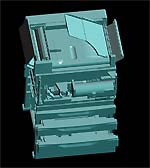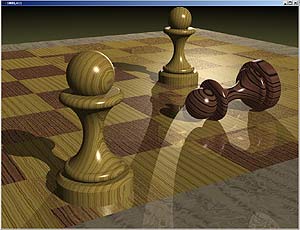In Windows 2000 the Pentium 4 chip comes out a
head. There is a patch for Sysmark 2001 when run in WindowsXP that fixes a problem with the
SSE compatibility of the Athlon XP. Without it, under Windows XP only, Sysmark doesn't utilize
the SSE compatibility of the Athlon XP. The patch doesn't affect Sysmark, but just
allows the Athlon XP use it's SSE-compatible instructions within 3DNow! Pro according to AMD.
In any event, the differences between the
XP2000+ and P4 are slight as far as office productivity is concerned. The
difference is a little more pronounced when SysMark examines Internet Content Creation applications however.
SuperPI calculates the number PI to 1 Million digits in this
raw number crunching benchmark. The benchmark is fairly diverse and allows the
user to change the number of digits of PI that can be calculated from 16
Thousand to 32 Million. The benchmark, which uses 19 iterations in the test, is
set 1 Million digits.
Lower numbers denote faster calculation times
(seconds), and hence, better performance.
| Super PI (1 Million digits) Benchmark Results |
|
Processor |
seconds |
Ranking |
| 1. |
Athlon XP2000+ |
75 sec |
 |
| 2. |
Pentium4 2.0GHz |
95 sec |
 |
SuperPI is a fun benchmark for us. In this raw
example of pure calculations, it takes 95 seconds on the 2.0GHz Pentium 4 for the SuperPi
application to calculate Pi to 1,000,000 digits. On the other hand, it takes just 75
seconds on the Athlon XP 2000+ do the exact same set of
calculations. Again, we are seeing a prime example of the Athlon's raw FPU prowess.
SPECviewperf™ is a portable OpenGL performance benchmark
program written in C. It was developed by IBM. Later updates and significant
contributions were made by SGI, Digital and other SPECopcSM project group members. SPECviewperf provides a vast
amount of flexibility in benchmarking OpenGL performance. Currently, the program
runs on most implementations of UNIX, Windows NT, Windows 95/98 and
Linux.

Higher numbers equate to better performance.
SPECviewperf is a professional 3D CAD based benchmark.
The XP2000+ wins in probably the most important test, the Light_04 test, where
the system is
pretty much all processor limted. In the other tests, the DRV_07
and DX_06 the Athlon XP2000+ does equally well at putting the Pentium 4 2.0GHz to shame. These
tests are more of an overall system benchmark. It is common knowledge that the Athlon's have always
had more powerful FPU's then their Intel counterparts which we are seeing
for the most part in SPECviewPerf.
The Persistence of Vision Ray Tracer (POV-Ray) is an all-round
excellent package, but there are two things that particularly make it
stand out above the rest of the crowd. Firstly, it's free, and
secondly, the source is distributed so you can compile it on
virtually any platform
Lower numbers denote faster calculation times
(seconds), and hence, better performance.

| POVRay Benchmark Results |
|
Processor |
seconds |
Ranking |
| 1. |
Athlon XP2000+ |
189 sec |
 |
| 2. |
Pentium4 2.0GHz |
299 sec |
 |
The benchmark results listed above are for rendering a single image of the pawns
wire frame at 1024x768 resolution (AA0.3). The faster system comes in with the lower
time to complete the job, and in this case the Athlon XP2000+ kills the P4
2.0GHz by a good margin (110sec). AMD chips have always been known for their
ability to do big-time number crunching.
